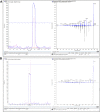Unearthed opium: development of a UHPLC-MS/MS method for the determination of Papaver somniferum alkaloids in Daunian vessels
- PMID: 37564111
- PMCID: PMC10410162
- DOI: 10.3389/fchem.2023.1238793
Unearthed opium: development of a UHPLC-MS/MS method for the determination of Papaver somniferum alkaloids in Daunian vessels
Abstract
Introduction: The analysis of organic residue in ancient vessels to investigate early-age civilization habits is an important archeological application that needs advanced analytical methods. However, these procedures should meet inherent requisites such as low sampling invasiveness and high sensitivity for trace analysis. This study deals with the development of advanced analytical methods for the detection of opium alkaloids in ceramic vessels and its first application to the study of Daunian pots dating back to the VIII-IV sec BC. Methods: All the stages of the analytical procedure, from sampling to analysis, were carefully optimized. Concerning sampling, the traditional scraping approach was compared with a swabbing strategy which permitted minimizing sample encroachment. Extraction was based on pressurized liquid extraction or ultrasound-assisted liquid extraction, followed by dispersive liquid-liquid microextraction, which allowed concentration enrichment. On the other hand, a UHPLC-MS/MS method was specifically developed and validated to obtain reliable data. Some Daunian pots, belonging to the Ceci-Macrini private archeological collection, were selected for sample withdrawal as their iconography could suggest opium usage. Results: Several of the analyzed samples resulted positive to thebaine and less frequently to morphine and codeine; furthermore, 70% of the analyzed items tested positive for at least one opium alkaloid. Positive findings were common to all the samples collected in the pots, suggesting that scraping and swabbing provided comparable results and validating this unusual sampling strategy. All samples were additionally analyzed by UHPLC-HRMS to further improve the confidence level of the identified compounds. The obtained results shed new light on the hypothesis of opium usage by the ancient Daunian civilization. Furthermore, this study provided suitable analytical tools for further investigations on the same topic, with a good level of confidence in the quality of the results.
Keywords: Daunian; archeological ceramics; mass spectrometry; opium alkaloids; pressurized liquid extraction.
Copyright © 2023 Vincenti, Montesano, Ciccola, Serafini, Favero, Pallotta, Pagano, Di Francesco, Croce, Leone, Muntoni and Sergi.
Conflict of interest statement
The authors declare that the research was conducted in the absence of any commercial or financial relationships that could be construed as a potential conflict of interest.
Figures



References
-
- Briggs L., Demesticha S., Katzev S., Wylde Swiny H., Craig O. E., Drieu L. (2022). There’s more to a vessel than meets the eye: Organic residue analysis of ‘wine’ containers from shipwrecks and settlements of ancient Cyprus (4th–1st century bce). Archaeometry 64, 779–797. 10.1111/arcm.12747 - DOI
-
- Cank K. B., Henkin J. M., Cook A. G., Oberlies N. H. (2021). Droplet probe: A non-destructive residue analysis of wari ceramics from the imperial heartland. J. Archaeol. Sci. 134, 105468. 10.1016/j.jas.2021.105468 - DOI
-
- Chovanec Z., Rafferty S., Swiny S. (2012). Opium for the masses. Ethnoarchaeology 4, 5–36. 10.1179/eth.2012.4.1.5 - DOI
-
- Kałużna-Czaplińska J., Rosiak A., Kwapińska M., Kwapiński W. (2016). Different analytical procedures for the study of organic residues in archeological ceramic samples with the use of gas chromatography-mass spectrometry. Crit. Rev. Anal. Chem. 46, 67–81. 10.1080/10408347.2015.1008130 - DOI - PubMed
LinkOut - more resources
Full Text Sources

